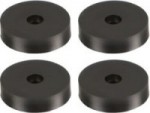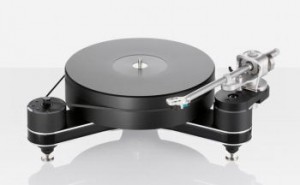Location, Location, Location ..
Is the catch cry of the real estate industry and is very relevant in the world of audio. Almost every component within your system, including cables, can do with a “good place to live”, and all of these “locations“ have relevance to performance. The place to start are the sources, especially the turntable. Anything compromised in their set up and location travels right through the system to be finally delivered by the speakers. An old audio industry adage is “garbage in, garbage out”.
App licable to all components is the requirement for a stable, solid and generally weighty stand, rack or other storage item. The mass and stability of the stand along with the mass of the components themselves, is beneficial, as all components will have some level of vibration, caused by the mains AC frequency. Small, yes, of detrimental consequence?…. Often.
licable to all components is the requirement for a stable, solid and generally weighty stand, rack or other storage item. The mass and stability of the stand along with the mass of the components themselves, is beneficial, as all components will have some level of vibration, caused by the mains AC frequency. Small, yes, of detrimental consequence?…. Often.
We support the Atacama line up of tiered shelves and racks. They provide several ranges of attractive and effective products. The Pro-Ject Wall Mount Bracket is uniquely helpful for turntables and provides a really solid and stable base for your turntable.
of attractive and effective products. The Pro-Ject Wall Mount Bracket is uniquely helpful for turntables and provides a really solid and stable base for your turntable.
The most affected component of all is the turntable. The cartridge operates with a stylus reading the tiny modulations that exist within the record groove. A small experiment you may consider, is to tap gently on the turntable and see if this is reproduced through the system. The better the turntable, the more it will be able to isolate and negate those vibrations. The materials and level of engineering are directly related to performance and that is usually reflected in the price. Turntables can vary greatly in the way they address these issues. Any vibrations that can affect the “stylus/groove“ interface are absolutely the enemy.
Vibrations w hether they be floorborne and or airborne, like someone dancing or heavy footfalls through the room. Maybe a speaker, especially a subwoofer, creating low frequency vibrations, can really adversely affect a turntable, both as pressure waves through the air or vibrations through the floor. All are definitely detrimental. Some very effective and realistically priced vibration dampers are available. An example is the Damp It Kit @$50 and there are a huge number of other products out there that can address this issue. Again, materials and engineering reflect the effectiveness and asking price.
hether they be floorborne and or airborne, like someone dancing or heavy footfalls through the room. Maybe a speaker, especially a subwoofer, creating low frequency vibrations, can really adversely affect a turntable, both as pressure waves through the air or vibrations through the floor. All are definitely detrimental. Some very effective and realistically priced vibration dampers are available. An example is the Damp It Kit @$50 and there are a huge number of other products out there that can address this issue. Again, materials and engineering reflect the effectiveness and asking price.
Generally, the design of turntables fall into two categories. They are direct drive and belt drive. The direct drive has the turntable platter directly coupled to the motor. The motor therefore needs to be of high quality (low noise and high torque), and well capable of driving the platter at a consistent speed. Vibrations from a cheap direct drive motor will be transmitted into the turntables platter, then onto the record and then via the stylus into the system). Direct drives generally have a speed control system enabling subtle changes to the rotational speed of the platter. It is worth noting, the stylus, cartridge and arm can affect the speed when lowered onto the record. The measurement for this speed instability is called wow and flutter. Direct drives are generally suited to favourable environments where the turntable is not subject to most of those vibrations we wish to avoid. These turntables are particularly used by DJ’s who are inclined to perform certain tasks that only a direct drive is suited to and often in a nightclub. Also used in studios and radio stations that are purpose built for good sonic integrity and generally deliver a good sonic outcome.
Mos t turntables however are belt drive. While the same qualities of motor performance, that is low noise and high torque are important in belt drive turntables. The isolation of the motor is an advantage in that the belt is unlikely to transmit any noise content to the platter/record and subsequently into the system. Belt drives tend also to isolate the turntable from external vibration and are generally quite serviceable and forgiving in their performance.
t turntables however are belt drive. While the same qualities of motor performance, that is low noise and high torque are important in belt drive turntables. The isolation of the motor is an advantage in that the belt is unlikely to transmit any noise content to the platter/record and subsequently into the system. Belt drives tend also to isolate the turntable from external vibration and are generally quite serviceable and forgiving in their performance.
Your turntable’s performance is directly related to the amount of awareness, and actions you may embrace. Importantly and thankfully, many of these cautions are inexpensive and downright cheap when compared with paths that encourage expense, but never really address basic set up problems.
Amplifiers, Integrated, Pre and Power are components where the heat generated needs be dissipated efficiently and quickly. Most amplifiers have ventilation slots so it is critical that they are able to breathe freely. If a component is stacked upon an amplifier, the chances are that the amp will overheat, maybe shut down, wear out faster and fail s ooner requiring some surgical work … or even worse DIE completely! The component sitting atop the amplifier may also have issues with the heat generated from the amplifier. So, excessive heat is the enemy of most electronic components. Amplifiers within restricted places like cabinets and cupboards, will need some good air exchange. Fans will help but introduce their own vibrations into the equation. Again there are inexpensive resolutions for this with just a little thought and effort required.
ooner requiring some surgical work … or even worse DIE completely! The component sitting atop the amplifier may also have issues with the heat generated from the amplifier. So, excessive heat is the enemy of most electronic components. Amplifiers within restricted places like cabinets and cupboards, will need some good air exchange. Fans will help but introduce their own vibrations into the equation. Again there are inexpensive resolutions for this with just a little thought and effort required.
Cables ……. What have they to do with location you may ask? While cabling is very much a buzzword these days, there are some basics to follow that again will maximize performance without substantial outlay.
As usual the turntable’s cabling is of critical importance. The signal coming out of a turntable is minuscule, typically millivolts and needs to go through a dedicated amplifier input, marked “phono”. If your amplifier does not have this phono input then a stand alone phono stage is required. Prior to this phono stage the signal is very prone to picking up noise. The AC mains cables should be kept as far away as possible from the signal leads coming from the turntable. This noise content can be quite audible particularly with the low level signal from a turntable. The same need be said for all the other components. It is very important, as best as possible to isolate mains power cables from signal cables. If they have to cross over, do it at 90 degrees and minimize noise induction.
A really simple summary, vibrations are the enemy, heat is the enemy, induced mains noise is the enemy. All these enemies are quite easily minimized and often eliminated.

Hi Pierre
The cheapest upgrade I have done, is to level my turntable with those rubber shims you gave me!
Elementary I know , but I presumed my entertainment unit was level. Placing a small spirit level on the platter told me otherwise.
Thanks again for the excellent service.
Andrej